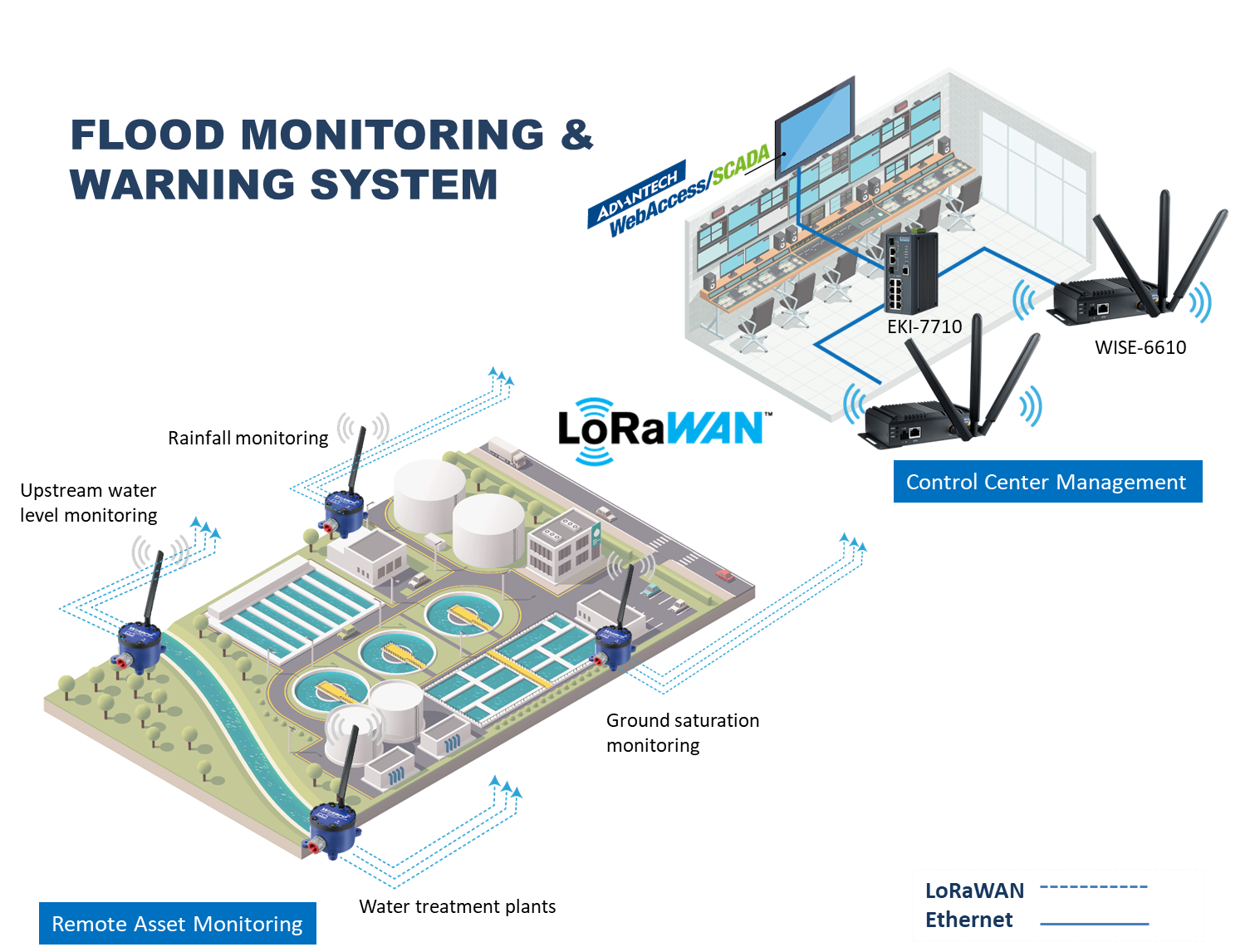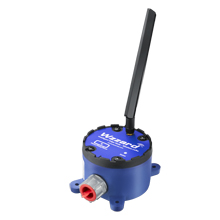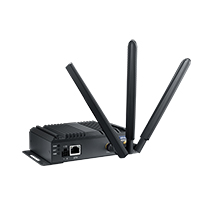Advantech LoRaWAN Solution for Flood Monitoring and Warning System
28/09/2017
Challenge
According to Munich RE, one of the world’s leading reinsurers, overall losses from natural disasters in 2016 was approximately US$175 billion worldwide. Among all disasters, floods were ranked sixth, accounting for US$40 billion. Thus, determining how to precisely predict flood events and efficiently minimize resulting losses has become a high priority.
Flooding and excessive rainfall can cause considerable disruption or damage to critical assets and infrastructure. Water treatment plants, for example, are typically located near water bodies, and many of them are situated on flood plains. Thus, implementing an effective FMDS at such facilities requires overcoming challenges in network deployment, particularly because the system must be able to function under high humidity and handle acute changes in temperature in order to provide timely reporting on environmental conditions.

The Solution
The ability to track data such as rainfall, ground saturation, and upstream water levels enables companies and utility services to receive early flood warnings and take preventative action. Even for the many similar systems that are already in place, their effectiveness can be improved by adopting the Wzzard LRPv series of products.
Advantech’s Wzzard LRPv LoRaWAN nodes and WISE-6610 LoRaWAN gateways can be used to establish low-power wireless sensor networks with LoRaWAN technology, and this can enable the reporting of data to your computer or cloud application via a central network gateway. The most useful gateways can utilize both wired and wireless data connections, meaning that that you can position them in most locations.
Your software can then combine your data with third-party information such as weather reports from national weather services. This enables your system to make intelligent decisions such as issuing in-time SMS notifications to the public for evacuation, signaling and broadcasting disaster warnings, and convening emergency response teams.

Wzzard LRPv LoRaWAN nodes are placed in remote areas and connected to sensors such as those for monitoring water levels, ground saturation, and rainfall. The nodes transmit sensor data via LoRa wireless technology to a WISE-6610 gateway in the control center located miles away.
When the WISE-6610 LoRaWAN gateway receives data sent from the Wzzard LRPv LoRaWAN nodes, it passes data to the PC for application server and SCADA management.
Since a single control center might be responsible for monitoring multiple sites, a switch can facilitate collecting and organizing data from many WISE-6610 gateways prior to passing the data to a PC.
With sufficient sensor data, the system can assist in analyzing the severity of a flood and what action items are required.
Features, Advantages and Benefits

LoRaWAN Wireless Network Technology
LoRaWAN is a proprietary chirp spread spectrum radio modulation technique for use in a low-power wide-area network (LPWAN). It is a WAN specification designed to enable long-range, low-bit-rate communication among “things” (i.e., connected objects) such as battery-powered sensors, and it uses license-free sub-GHz radio-frequency bands such as 196, 433, and 868 Mhz in Europe and 915 MHz in North America. An LPWAN may be used to create a wireless sensor network or a third-party service or infrastructure.
The Wzzard LRPv LoRaWAN node and WISE-6610 gateway support wireless long-range network communication without the need to pay telecommunication fees, thus reducing network operating costs considerably. This is particularly pertinent for reducing the cost of flood monitoring because most water bodies are large and do not have control centers located near them. Furthermore, traditional wireless solutions (e.g., access points) have a limited data transmission range and thus force users to adopt an intensive approach to node deployment. Even though cellular routers are unaffected by such problems, they require paying telecommunication fees...
IP66 Enclosure for Remote Outdoor Sites
Dual Powr-saving Mode And Alarm System
The Wzzard LRPv LoRaWAN node has two power-saving modes: sleep mode (for when a node is not in use) and operation mode (for scheduled data transmissions). For instance, if a node were scheduled to report sensor data twice per hour, then sleep mode would automatically activate when the node is not in use, and operation mode would wake the node when the data must be transmitted, thus achieving the goal of energy efficiency. An alarm system is installed to notify users when a value has exceeded a given threshold. For example, when a flood or storm is approaching, it brings in a tremendous amount of water; in this case, the alarm system will notify users when water levels have exceeded a certain level so that disaster prevention measures can be implemented.
Thus, the smart design of the power-saving modes and alarm system reduces costs by saving power while promoting safety by notifying users when emergent action should be taken.
Conclusion
Advantech's LoRaWAN solution, a highly integrated LoRa sensing platform for applications ranging from I/O sensor data management to network protocol conversion, can be utilized to form a sensor network, paying immediate dividends by cutting maintenance costs while increasing overall productivity. Wzzard LRPv network gateways connect to your application server or SCADA for data access using the MQTT protocol via either an Ethernet or wireless data network.
The described features make it possible to place sensors and Internet gateways in locations where AC power or wired Ethernet is unavailable, and the high flexibility of the dual power-saving modes and alarm system can minimize costs by conserving power and preventing disasters.
Product Information

- Rugged, IP66-rated, fiber-reinforced polyester PBT enclosure
- Ultra low power consumption with battery and external power input (3.7 ~ 12 V)
- Industrial-grade with a wide operating temperature range (-40 ~ 75 °C).

- Existing software user modules plus fully supported application development gives more customization options for users
- Low power consumption
- Industrial-grade with a wide operating temperature range (-40 ~ 75 °C)
- Supports IoT protocols
Edited by
Kuei Lang 郎閣揆
kuei.lang@advantech.com.tw
Industrial IoT Group-Marketing
Jimmy Cooper
